| dc.contributor.author | Bjørneklett, Rune | en_US |
| dc.contributor.author | Solbakken, Vilde | en_US |
| dc.contributor.author | Bostad, Leif | en_US |
| dc.contributor.author | Fismen, Anne-Siri | en_US |
| dc.date.accessioned | 2019-03-29T15:12:01Z | |
| dc.date.available | 2019-03-29T15:12:01Z | |
| dc.date.issued | 2018-06-03 | |
| dc.Published | Bjørneklett RO, Solbakken V, Bostad L, Fismen AS. Prognostic factors in anti-neutrophil cytoplasmic antibody-associated glomerulonephritis with severe glomerular sclerosis: a national registry-based cohort study. Pathology Research International. 2018;2018:5653612:1-7 | eng |
| dc.identifier.issn | 2090-8091 | |
| dc.identifier.issn | 2042-003X | |
| dc.identifier.uri | https://hdl.handle.net/1956/19255 | |
| dc.description.abstract | Background. Classification of patients with anti-neutrophil cytoplasmic antibody-associated glomerulonephritis (ANCA-GN) into histological classes is useful for predicting a patient’s risk of progression to end-stage renal disease (ESRD). However, even in the worst prognostic group, the 5-year end-stage renal disease-free survival rate is as high as 50%. Objectives. To investigate those prognostic factors indicative of progression to ESRD in patients with ANCA-GN and sclerosing histology. Methods. Patients from the Norwegian Kidney Biopsy Registry between 1991 and 2012 who had biopsy verified pauci-immune glomerulonephritis, positive ANCA serology, and sclerosing histology were included. Cases with ESRD during follow-up were identified via linkage with the Norwegian Renal Registry. Potential prognostic factors with relevant cut-offs were compared in patients with and without progression to ESRD during follow-up. Results. Of 23 included patients, 10 progressed to ESRD. ESRD patients had a lower initial estimated glomerular filtration rate (eGFR; 21 versus 52 ml/min/1.73 m2) and a lower percentage of normal glomeruli (4% versus 15%). Five-year risks of ESRD with eGFR >15 versus ≤15 ml/min/1.73 m2 were 77% and 15%, with percentage normal glomeruli >10% versus ≤10%, 83% and 39%. Conclusions. eGFR and percentage of normal glomeruli are strong risk factors for ESRD in ANCA-GN with sclerosing histology. | en_US |
| dc.language.iso | eng | eng |
| dc.publisher | Hindawi | eng |
| dc.rights | Attribution CC BY | eng |
| dc.rights.uri | http://creativecommons.org/licenses/by/4.0/ | eng |
| dc.title | Prognostic factors in anti-neutrophil cytoplasmic antibody-associated glomerulonephritis with severe glomerular sclerosis: a national registry-based cohort study | en_US |
| dc.type | Peer reviewed | |
| dc.type | Journal article | |
| dc.date.updated | 2018-11-23T11:34:57Z | |
| dc.description.version | publishedVersion | en_US |
| dc.rights.holder | Copyright 2018 Rune Bjørneklett et al. | |
| dc.identifier.doi | https://doi.org/10.1155/2018/5653612 | |
| dc.identifier.cristin | 1631586 | |
| dc.source.journal | Pathology Research International | |

